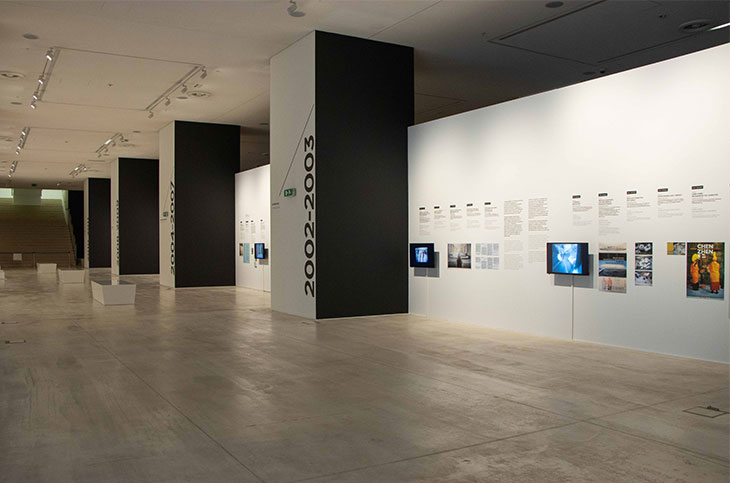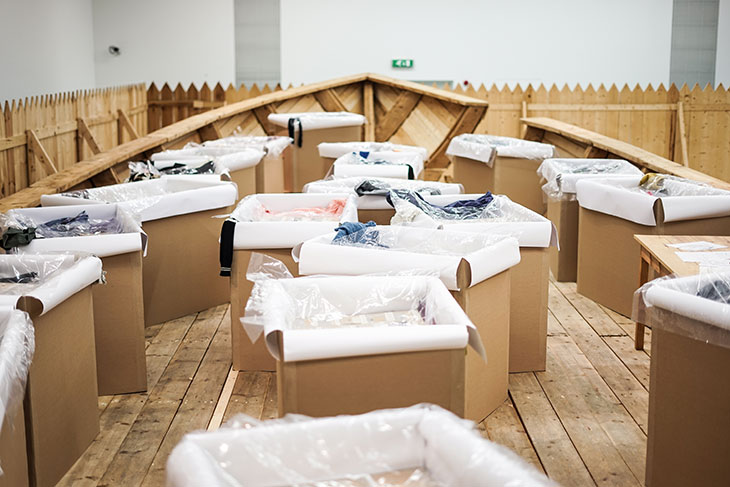When I moved to Greece in September, I was shocked to discover that the National Museum of Contemporary Art (EMST) in Athens had been closed for six months – with only whispers about when it might reopen. For the general public, outside of smaller-scale commercial galleries, contemporary art was all but invisible. I was left struggling to improve my Greek as I scoured through Athens’s libraries to discover its recent art history.
So it was a relief when EMST reopened at the end of February, seemingly ending a period of funding shortfalls, administrative problems and difficulties in selecting a permanent director. The collection was founded 20 years ago and in 2002 a 50-year lease was signed on a home for it: the former FIX brewery in central Athens. In the following years, during the continued construction delays, the museum operated through temporary exhibitions in sites across the city. Since then EMST has struggled to get its permanent home ready for the public, with only a fraction of the space operational since 2015 and the official opening repeatedly set back. The opening now is largely thanks to an additional €3m grant from the Stavros Niarchos Foundation and represents the first time a large portion of the collection is being displayed together. EMST has unwittingly become a symbol of the economic uncertainty of modern Greece and the general lack of state support given to contemporary art.

Installation view of ‘EMST Open’ at EMST Athens in 2020. Photo: Katerina Paraskeva
Unusually, the museum chose to open before its official inauguration, when the new director and exhibition programme will be announced. This was originally scheduled for 19 April but will inevitably now be delayed again, since all archaeological sites and museums in Greece are currently closed as part of the wider lockdown imposed to counteract the spread of Covid-19. When I met with EMST curators earlier this month they emphasised that the soft opening was due to their desire to have the space finally open for the public above all else.
Titled ‘EMST Open’, the museum’s opening exhibition is a display charting its history, and it feels necessary to address this head on. Positively, the display actually demonstrates how inventive EMST has been during these years of chaos, organising exhibitions of individual works from the collection in a variety of spaces, by an international roster of names including Gillian Wearing, John Baldessari and Rebecca Horn. The museum has been in many ways liberated by its lack of a permanent space, leading to opportunities such as its collaboration in 2017 with the curators of Documenta 14, who mounted a major exhibition of the EMST collection in the Fridericianum in Kassel.
Remarkable though these achievements are, the lack of a permanent collection display has clearly had an impact on the cultural landscape of Greece. The work of Greek artists is not widely known internationally and, realistically, only the most dedicated art lovers would have sought out the off-site exhibitions. With EMST flailing, scholarship in Greek art and the public’s access to international exhibitions has been severely stifled.

Installation view of Ilya Kabakov’s The Boat of My Life (1993) at EMST Athens in 2020. Photo: Katerina Paraskeva
Thankfully, the collection is worth waiting for. Much of it was purchased or specially commissioned in the economic high times during the lead-up to the 2004 Olympics in Athens, but it still feels relevant, with excellent pieces by Shirin Neshat, Ilya Kabakov and Jannis Kounnellis. There is a deep intelligence and political bent to many of the works on display and it’s a delight to see pieces by Greek artists like Chryssa, Rena Papaspyrou and Nikos Kessanlis next their international counterparts. At the opening press conference the Greek culture minister Lina Mendoni promised to fund new purchases and I hope they will deliver this and continue to build a collection of this quality. Of course, a contemporary museum has to be so much more than its collection, and the ones that thrive are also the best destinations. The modernist building, designed by Takis Zenetos, is a beautiful space but it still feels somewhat unfinished, with the library, cafe and restaurant still not open.
EMST remains a fragile being, and the arrival of Covid-19 has unfortunately only added to its difficulties. While on Instagram it boasted that there were more than 3,000 visitors within the first three days after opening, the museum has now had to delay its events programme and advertising across the city, as well as its official inauguration. EMST will need to fight to maintain its attendance numbers and relevance in the fast-paced world of contemporary art now it has a permanent space. On the basis of its history and achievements so far, however, this team might be better placed than many to face such a crisis.
For more information visit EMST’s website.

The brief end to the long wait for the National Museum of Contemporary Art in Athens
The National Museum of Contemporary Art (EMST) Athens. Photo: Stephie Grape
Share
When I moved to Greece in September, I was shocked to discover that the National Museum of Contemporary Art (EMST) in Athens had been closed for six months – with only whispers about when it might reopen. For the general public, outside of smaller-scale commercial galleries, contemporary art was all but invisible. I was left struggling to improve my Greek as I scoured through Athens’s libraries to discover its recent art history.
So it was a relief when EMST reopened at the end of February, seemingly ending a period of funding shortfalls, administrative problems and difficulties in selecting a permanent director. The collection was founded 20 years ago and in 2002 a 50-year lease was signed on a home for it: the former FIX brewery in central Athens. In the following years, during the continued construction delays, the museum operated through temporary exhibitions in sites across the city. Since then EMST has struggled to get its permanent home ready for the public, with only a fraction of the space operational since 2015 and the official opening repeatedly set back. The opening now is largely thanks to an additional €3m grant from the Stavros Niarchos Foundation and represents the first time a large portion of the collection is being displayed together. EMST has unwittingly become a symbol of the economic uncertainty of modern Greece and the general lack of state support given to contemporary art.
Installation view of ‘EMST Open’ at EMST Athens in 2020. Photo: Katerina Paraskeva
Unusually, the museum chose to open before its official inauguration, when the new director and exhibition programme will be announced. This was originally scheduled for 19 April but will inevitably now be delayed again, since all archaeological sites and museums in Greece are currently closed as part of the wider lockdown imposed to counteract the spread of Covid-19. When I met with EMST curators earlier this month they emphasised that the soft opening was due to their desire to have the space finally open for the public above all else.
Titled ‘EMST Open’, the museum’s opening exhibition is a display charting its history, and it feels necessary to address this head on. Positively, the display actually demonstrates how inventive EMST has been during these years of chaos, organising exhibitions of individual works from the collection in a variety of spaces, by an international roster of names including Gillian Wearing, John Baldessari and Rebecca Horn. The museum has been in many ways liberated by its lack of a permanent space, leading to opportunities such as its collaboration in 2017 with the curators of Documenta 14, who mounted a major exhibition of the EMST collection in the Fridericianum in Kassel.
Remarkable though these achievements are, the lack of a permanent collection display has clearly had an impact on the cultural landscape of Greece. The work of Greek artists is not widely known internationally and, realistically, only the most dedicated art lovers would have sought out the off-site exhibitions. With EMST flailing, scholarship in Greek art and the public’s access to international exhibitions has been severely stifled.
Installation view of Ilya Kabakov’s The Boat of My Life (1993) at EMST Athens in 2020. Photo: Katerina Paraskeva
Thankfully, the collection is worth waiting for. Much of it was purchased or specially commissioned in the economic high times during the lead-up to the 2004 Olympics in Athens, but it still feels relevant, with excellent pieces by Shirin Neshat, Ilya Kabakov and Jannis Kounnellis. There is a deep intelligence and political bent to many of the works on display and it’s a delight to see pieces by Greek artists like Chryssa, Rena Papaspyrou and Nikos Kessanlis next their international counterparts. At the opening press conference the Greek culture minister Lina Mendoni promised to fund new purchases and I hope they will deliver this and continue to build a collection of this quality. Of course, a contemporary museum has to be so much more than its collection, and the ones that thrive are also the best destinations. The modernist building, designed by Takis Zenetos, is a beautiful space but it still feels somewhat unfinished, with the library, cafe and restaurant still not open.
EMST remains a fragile being, and the arrival of Covid-19 has unfortunately only added to its difficulties. While on Instagram it boasted that there were more than 3,000 visitors within the first three days after opening, the museum has now had to delay its events programme and advertising across the city, as well as its official inauguration. EMST will need to fight to maintain its attendance numbers and relevance in the fast-paced world of contemporary art now it has a permanent space. On the basis of its history and achievements so far, however, this team might be better placed than many to face such a crisis.
For more information visit EMST’s website.
Unlimited access from just $16 every 3 months
Subscribe to get unlimited and exclusive access to the top art stories, interviews and exhibition reviews.
Share
Recommended for you
The Albertina Modern’s opening has been delayed – so what are we missing out on?
The contemporary art satellite of the Albertina was set to open last week. Visitors will find solace there, says its director, when the lockdown is over
The successes and failures of Documenta in Athens
The decision to stage part of the 14th Documenta in Athens has been widely debated. Now that it’s open, what are the highlights of the programme?
Is Documenta exploiting the economic crisis in Athens?
This year Documenta will be split between Kassel and Athens. Is this ‘crisis tourism’ or will it spotlight the city’s overlooked contemporary art scene?